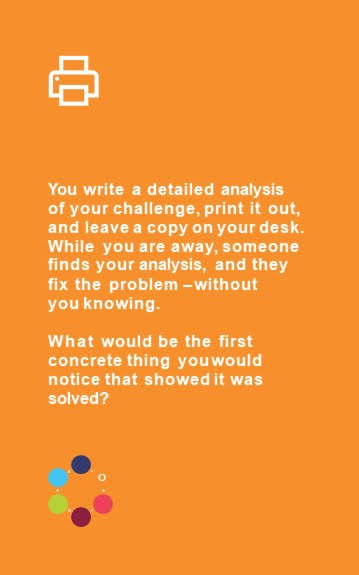I recently worked with a corporate team, and we were going through solution-focus, coaching, and problem-solving.
A discussion came up about the miracle question.
The miracle question comes from a body of knowledge called solution-focused. The miracle question is helpful after the team or the person you’re working with identifies their best hopes for the time together.
SOLVEDcards – Situation
We begin by exploring detailed information from the team and the individuals on the team. Working to create a coherent story about the current environment, what is working well, their hopes for the time together, and what better looks like in detail for each team member.
SOLVEDcards – Observation
Then we go into Observation questions.
A classic observation question is the Miracle Question.
And the Miracle Question, as initially developed by Steve de Shazer, is framed the following way.
I’m going to ask you kind of a weird question.
“Suppose you leave this meeting today, or you leave here today, go home, and eat dinner. You do what you usually do in the evening, go to bed at that time, and while you’re asleep, a miracle happens.
[The miracle is that what you want to have happen. For example, we will increase our trust in our customers. The customers will show us higher acceptance of the likelihood of taking our deal.]
And because you are asleep, you are unaware of the miracle happening. You wake up tomorrow morning, do your routine, and show up at work; what’s the first clue or the first thing you would notice that lets you know the miracle happens?”
The point behind the miracle question is not to create a miracle or not to suspend belief. It’s not even to play magical utopian thoughts. It is to begin identifying what differences will happen when you see the solution and increase progress.
Miracle Question Variation

I made a variation years ago as part of my SOLVEDcards deck.
It happened with a group of airline mechanics.
I was at the client’s location for three days, and they wanted to learn innovation tools. We did some TRIZ tools, and we did creative problem-solving tools and solution-focused tools. These mechanics were having particular technical challenges.
On day two of going through the tools, they tried to solve a mechanical problem.
This miracle question variation I use more with corporate teams.
- They went through the mechanical challenge, or you would with your team discuss their hopes and what they would like to happen.
- Form a detailed description of what better looks like or progress looks like.
Then you would say with the group:
“You write a detailed analysis of your challenge and print it out. You leave a copy on your desk today while you leave work.
While you’re away from work, someone finds your analysis and fixes the problem without you knowing. What would be the first concrete thing you notice that showed you it was solved.”
I like this question as a variation because it gives people a concept of understanding that;
- A fresh pair of eyes that may not be there, hence observation outside their silo
- Widening their spotlight thinking can create new ways to find things.
- Thinking about how somebody else makes progress on this.
- Or how would somebody else solves this challenge puts you in an interactional thinking place where you know other people can help you in the process.
I like this version, the Miracle Question. It works. Try it out. See how it works.
Together, we make progress.

